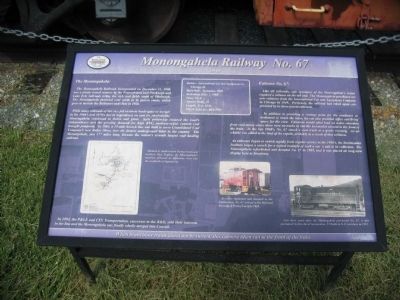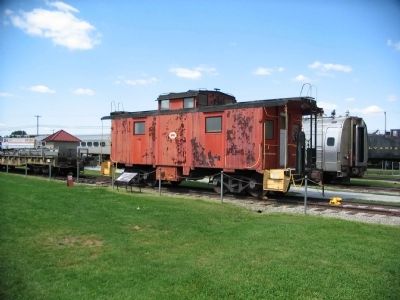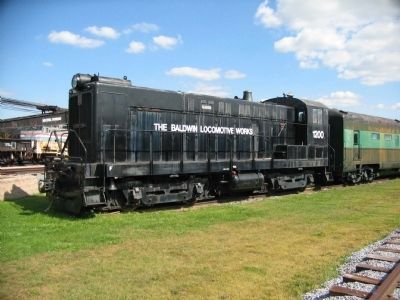Strasburg Township in Lancaster County, Pennsylvania — The American Northeast (Mid-Atlantic)
Monongahela Railway No. 67
1949
The Monongahela Railroad, incorporated on December 31, 1900, was a jointly owned venture by the Pennsylvania and Pittsburgh and Lake Erie railroads to tap the rich coal fields south of Pittsburgh. The Monongahela funneled coal north to is parent roads, which grew to include the Baltimore and Ohio in 1926.
While many railroads of this size fell victim to bankruptcy or merger in the 1960's and 1970's due to the dependency on coal for survival, the Monongahela continued to thrive and grow. Split ownership ensured the road's independence and the growing demand for high BTU, medium-sulfur content coal brought prosperity. In 1984, a 15-mile branch line was built to serve Consolidated Coal Company's new Bailey Mine, now the largest underground mine in the country. The Monongahela, just 177 miles long, became the nation's seventh largest coal hauling railroad.
In 1993, the P&LE and CSX Transportation, the successor to the B&O, sold their interests in the line and the Monongahela was finally wholly merged into Conrail.
Builder:
International Car and Equipment Co., Chicago, IL
Build Date: September 1949
Retirement Date: c. 1989
Class: NE-6
Number Built: 10
Length: 37 ft. 10 in.
PHMC Loan no.: RR8.1990
Caboose No. 67:
Like all railroads, safe operation of the Monongahela's trains required a caboose on the tail end. The Monongahela purchased ten new cabooses from the International Car and Equipment Company in Chicago in 1949. Previously, the railroad had relied upon cars provided by its three parent railroads.
In addition to providing a vantage point for the conductor or brakeman to watch the train, the car also provided office and living space for the crew. Cabooses would often lead on trains returning from coal mines where there were no tracks to run the locomotive around to the front of the train. In the late 1960's, No. 67 struck a coal truck at a grade crossing. An air whistle was added to the roof of the cupola, probably as a result of that collision.
As cabooses began to vanish rapidly from regular service in the 1980's, the Smithsonian Institute began a search for a typical example of such car to add to its collection. The Monongahela refurbished and donated No. 67 in 1989, and it was placed on long-term display here in Strasburg.
(Banner across bottom of marker): When branchline trains could not be turned, this caboose often ran at the front of the train.
Erected by Railroad Museum of Pennsylvania.
Topics. This historical marker is listed in this topic list: Railroads & Streetcars. A significant historical month for this entry is September 1949.
Location. Marker has been reported missing. It was located near 39° 58.944′ N, 76° 9.729′ W. Marker was near Strasburg, Pennsylvania, in Lancaster County. It was in Strasburg Township. Marker could be reached from Gap Road (Pennsylvania Route 741) east of Bishop Road, on the right when traveling east. Located in the outdoor display lot for the Pennsylvania Railroad Museum. Touch for map. Marker was at or near this postal address: 300 Gap Road, Ronks PA 17572, United States of America. Touch for directions.
Other nearby markers. At least 8 other markers are within 3 miles of this location, measured as the crow flies. Reading Observation No. 1 (here, next to this marker); Strasburg Rail Road (about 400 feet away, measured in a direct line); History of Railroad Pump Cars (approx. 0.2 miles away); 37 East Main Street (approx. ¾ mile away); 33 East Main Street (approx. ¾ mile away); Original Head Race & Water Turbine (approx. 1.9 miles away); Soudersburg Methodist Church (approx. 2.3 miles away); Leaman Place (approx. 2.8 miles away). Touch for a list and map of all markers in Strasburg.
More about this marker. On the lower left is a map showing the Monongahela's lines. Situated in southwestern Pennsylvania and northern West Virginia, the Monongahela's mainline followed its namesake river into the coalfields of Appalachia. On the lower right is a small photo of the caboose. Recently repainted and donated to the Smithsonian, No. 67 arrived at the Railroad
Museum of Pennsylvania in 1988. Also on the lower right is a photo of a switch locomotive. Just three years after the Monongahela purchased No. 67, it also purchased its first diesel locomotives, 27 Baldwin S-12 switchers in 1952.
Credits. This page was last revised on August 19, 2023. It was originally submitted on June 14, 2009, by Craig Swain of Leesburg, Virginia. This page has been viewed 1,290 times since then and 119 times this year. Last updated on August 17, 2023, by Carl Gordon Moore Jr. of North East, Maryland. Photos: 1, 2, 3. submitted on June 14, 2009, by Craig Swain of Leesburg, Virginia. • Bill Pfingsten was the editor who published this page.


